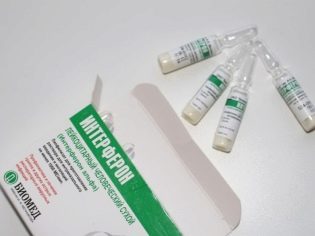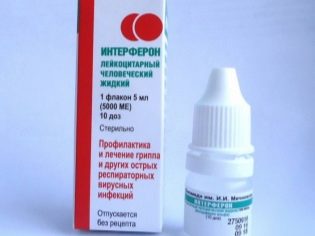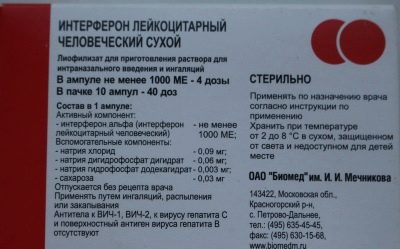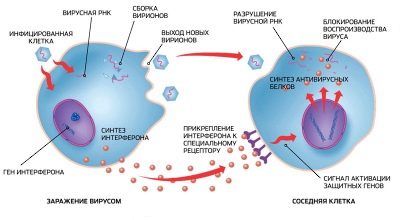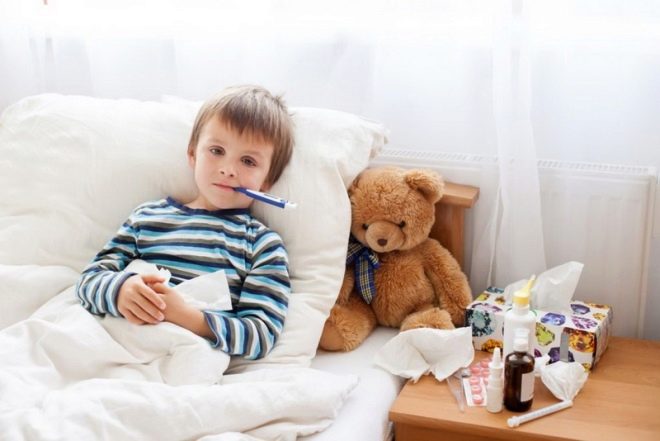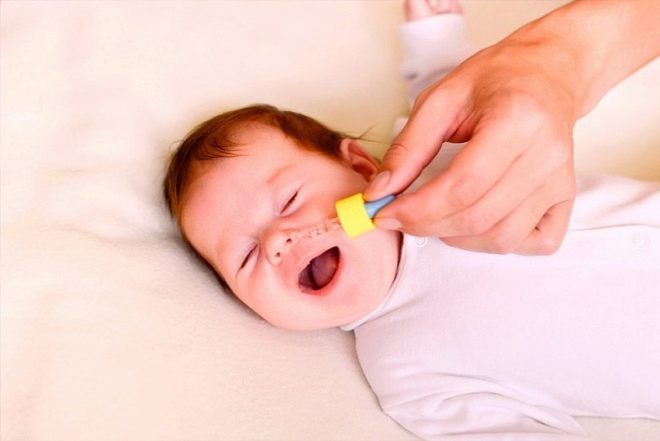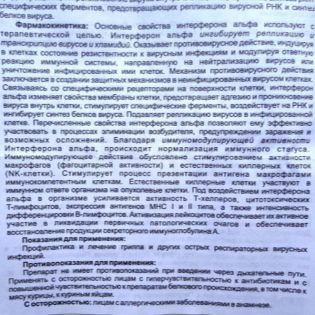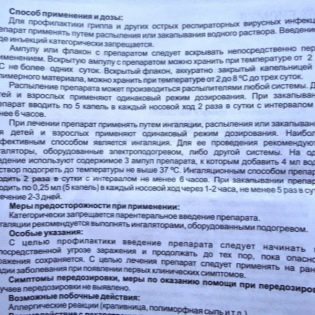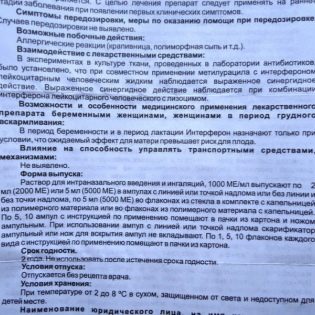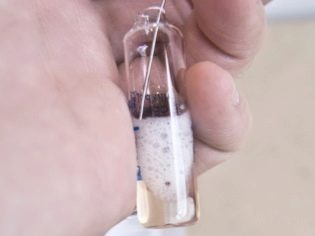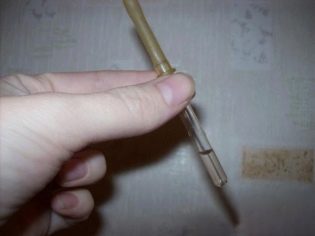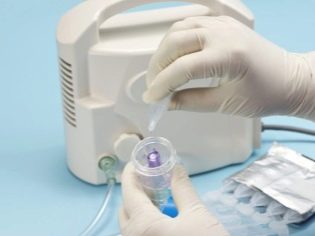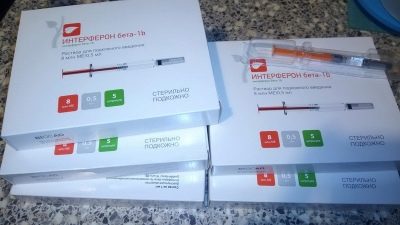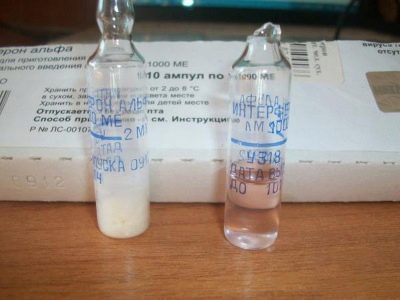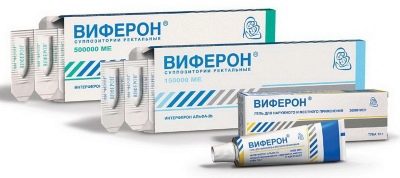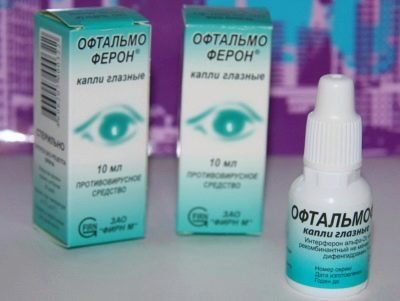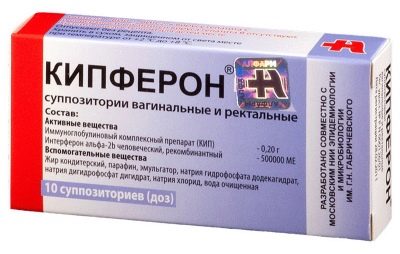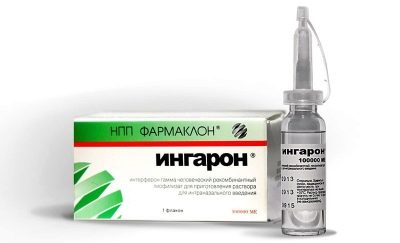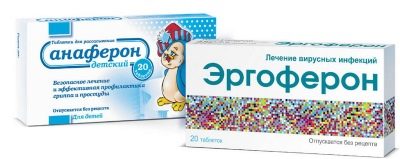Interferon for children: instructions for use
Interferons are called protein molecules that are formed in the human body when the temperature rises in response to exposure to an infectious agent, such as an influenza virus. Thanks to these proteins, the cells become less vulnerable to viral infection, and the disease passes faster.
The discovery and study of interferons has prompted scientists to create drugs that will contain such proteins and help in the treatment of viral diseases. This is how drugs called “Interferons” and many of their counterparts, as well as antiviral drugs, are able to stimulate the synthesis of interferon in the body of a sick person. Consider in more detail the drug called "Interferon" and, in particular, its use in children.
Release form
In our country, Interferon is manufactured by Microgen, Biomed, SPbNIIVS and Biocad. They are also engaged in the production of serums, toxoids, bacteriophages and other drugs.
Interferon is presented in pharmacies in two forms.
- Lyophilisate. It should be diluted to obtain a therapeutic solution used for inhalation, nasal drops or intramuscular injections. It is sold in glass ampoules, packed in cartons of 5-10 pieces. The contents of the ampoule is a porous mass of white with a cream, yellowish or pink tint. Sometimes ampoules with a solvent are attached to the lyophilisate, and some manufacturers include spray nozzles in the packaging to facilitate intranasal use of the drug.
- Ready sterile solution. It is packaged in bottles or ampoules of 2 ml or 5 ml and sold in boxes of 1, 5 or 10 pieces. The medicine itself is light pink or colorless, and may be slightly opalescent.
Composition
Most drugs called Interferon contain alpha-type proteins. It is them that we will consider in more detail, since Interferon Beta is prescribed for multiple sclerosis and is not used in childhood.
If on the package it says "human leukocyte," then this interferon is obtained from white blood cellstherefore, the active substance contains not only protein molecules, but also leukocytes. The presence in the name of the funds the words "recombinant" indicates that such interferon is obtained outside the human bodyas a rule, it is produced by Escherichia coli, in which a special gene is inserted. This simplifies the production of the drug and does not allow the transfer of any diseases through donor cells.
One ampoule of a lyophilisate contains 1000 IU or 10,000 IU of interferon alfa. A lower dosage agent is indicated for inhalation and nasal administration, and higher concentration preparations are used for injections.. The dosage of interferon in the finished sterile liquid solution is 1000 IU per 1 ml.
Other components of the ampoule with the lyophilisate are not included, and there are also auxiliary ingredients in the liquid "Interferon". These include sterile water and sodium dihydrogen phosphate, as well as hydrogen phosphate and sodium chloride. If in the box with “Interferon” in the form of a lyophilisate there are also ampoules of the solvent, then they are water for injection.
Operating principle
Interferon does not have a direct antiviral effect, but such proteins are able to change cells that are adjacent to the diseased, as a result of which viral particles cannot multiply in them, which prevents the spread of infection to healthy tissues. In addition, interferon has a stimulating effect on the immune system. Under his influence, substances that activate T-cells, natural killer cells and macrophages are more actively secreted.
Indications
"Interferon" is often prescribed for influenza or other acute respiratory infections caused by viruses, as well as for the prevention of such diseases. In such cases, the tool is used either in the nose or in the form of inhalation.
Injection drug is used in such serious diseases as hepatitis C, lymphoma, kidney carcinoma, melanoma, leukemia and so on.
Are children prescribed?
Drugs containing interferons alpha, it is permissible to use in childhood, but only on prescription.
You can drip “Interferon” into your nose from birth, and inhalations are given to children over 3 years old.
Contraindications
"Interferon", containing alpha-type proteins, is not used intranasally and inhalation only with hypersensitivity to protein preparations. But if the child has allergic diseases, it is necessary to use the medicine with caution.
It is also important to remember that a lyophilisate intended for use in the nose and for inhalation is not allowed to be injected.
As for Interferon, which is administered in injections, there are quite a few contraindications, including hepatitis, heart disease, thyroid pathology, and so on, so this medicine is not used without a doctor's prescription.
Side effects
If Interferon is prescribed for inhalation treatment or in the nose, then it often does not cause any unpleasant side effects. Only in rare cases due to the use of such a drug can an allergic reaction occur.
If the drug is injected, it can cause nausea, muscle pain, fever, low blood pressure, diarrhea, drowsiness, weakness, and other negative symptoms.
Application
Into the nose
Instructions for use involves the instillation or spraying of medication in the nasal cavity. If a lyophilisate is taken, the ampoule is opened just before use, adding boiled or distilled water to the inside of the dash. Shaking gently, wait until the contents completely dissolve and form a clear liquid (maybe a little opalescence) with no color or pink or yellowish tinge.
You can drip the prepared solution into the nose with a syringe without a needle or with a medical pipette, and spray it with an attached nozzle or other sprayer.
If Interferon is discharged for prophylaxis, it is started to be injected into the nose at the risk of infection. Such use lasts until the danger of a viral infection passes.
With the purpose of treatment, "Interferon" is prescribed as early as possible when the clinical symptoms of ARVI have only begun.
If the package with the lyophilisate has a special nozzle for spraying means into the nose, then you will also need a syringe to use it properly. Having accumulated the necessary amount of solution into it, the needle is replaced with a nozzle, put it to the nostril so that it is about 5 mm inside, and then sharply press the syringe piston so that the medicine is injected into the nasal passage. Next, remove the nozzle, put on a needle, pick up another dose of dissolved "Interferon", intended for the second nostril, again change the needle to the spray nozzle and inject the tool inside the nasal passage.
Before using "Interferon" in the nose, it is recommended to clean the ducts from mucus and dirt. The child should sit and throw back his head a little, and after spraying the solution do not move his head for about one minute. Spray head should be used for one patient only.
A single dose of the solution made from the lyophilisate is 5 drops in each nasal passage. (if it is necessary to drip the product) or 0.25 ml of the drug (if it is sprayed). The frequency of use depends on the evidence.
If the medication is used prophylactically, then “Interferon” needs to be dripped or sprayed twice a day, and between these two treatments the mucous membrane must pass at least 6 hours.
If the medication is prescribed for treatment, it is used intranasally at least 5 times a day at intervals of 1 or 2 hours.
Inhalation
Using "Interferon" in this way is considered the most effective in viral diseases of the respiratory system.
The procedure is carried out in a nebulizer twice a day. For one inhalation, they take 3 ampoules with lyophilisate and dissolve them in 4 milliliters of pure water, which is preheated slightly before this (but not more than up to +37 degrees).
Interferon can be breathed through the mouth and through the nose. The duration of such treatment is usually 2-3 days.
Injections
For injections use preparations containing 10 thousand IU of alpha-interferon in one ampoule. Injections are performed intramuscularly, and their frequency and single dosage, as well as the duration of such treatment, is determined individually.
Since such an introduction of "Interferon" may be a manifestation of the side effects of the drug, this method is prescribed to children less often and only in case of serious pathologies.
Drug interaction
If “Interferon” is sprayed into the nose or inhalation is performed with it, then it can be combined with any other medications, for example, with antipyretic agents or cough syrups. Injections can affect the effect of many other medicines, so the question of their compatibility with other prescribed medicines is decided individually by a specialist.
Terms of sale
To buy both forms of the drug in a pharmacy, you do not need a prescription from a doctor, but consultation with a specialist is recommended, as with treatment by any other means acting on the immune system. The price of "Interferon" is influenced by the form of the drug and the manufacturer. For example, for a 5-milliliter bottle from "Biomed" you need to pay about 120 rubles, and 10 ampoules with a lyophilisate from "Microgen" cost an average of 90-100 rubles.
Storage
The shelf life of the lyophilisate is usually 2 years, the finished solution is up to 24 hours. Sealed liquid "Interferon" can be stored for up to 2 years from the date of manufacture, an opened ampoule - no longer than a day, and an opened bottle - up to three days. Ampoules or bottles with any form of "Interferon" should be kept in the refrigerator, because the storage temperature recommended by the manufacturer ranges from +2 to +8 degrees Celsius.
Reviews and analogues
About the treatment of children "Interferon" can be seen mostly positive reviews, in which parents confirm its effectiveness in viral infections. The advantages also include affordable cost, ease of use, good tolerability and the ability to use in young patients. Among the shortcomings, many mothers call the storage characteristics of the drug.
Replacing "Interferon" may serve another drug that contains the same or similar components, therefore, also has an immunostimulating effect.
- "Viferon". The composition of this drug includes recombinant alpha-2b interferon. The tool is in demand for SARS, herpes infection, enterovirus, pneumonia, hepatitis and many other pathologies. The drug in the form of rectal suppositories and gel is used even in newborns, and Viferon ointment is prescribed for children over one year old.
- Grippferon. The basis of this medication also stands recombinant interferon, which belongs to the type of alpha-2b. Both forms of medication (nasal drops and nasal spray) are allowed from birth and are most often prescribed for viral lesions of the respiratory tract or to prevent it.
- "Genferon Light". Such a drug in the form of a spray and candles contains not only alpha-2b interferon, but also taurine - a substance that stabilizes membranes, accelerates recovery and normalizes metabolism in tissues. The drug is included in the complex treatment of SARS and many other infections, including bacterial. It can be used in the form of candles from birth, even in infants born prematurely, and the spray is prescribed from the age of 14.
- «Ophthalmoferon». The difference of such a drug based on alpha-interferon from analogs is its dosage form - the drug is represented by eye drops, therefore, it is in demand for various eye diseases. In addition, the drug includes another active ingredient - diphenhydramine. Children can drip it at any age.
- «Kipferon». This medicine, represented by suppositories, contains a combination of alpha-interferon and several types of immunoglobulins. It is prescribed for acute respiratory infections, intestinal infections, hepatitis, chlamydia, flu and other diseases. In children, these candles can be used from birth.
- «Ingaron». Unlike previous analogues, this medicine is lyophilized and contains gamma interferon. It can be used for flu, viral rhinitis, and other diseases from the age of 7 years.
In addition, if it is impossible to use interferon-based drugs, the doctor may prescribe drugs that stimulate the production of such protein compounds in the child’s body, for example:
- «Kagocel» - pills prescribed from the age of 3;
- "Amiksin" - Tilorone-based tabletting agent, approved from 7 years;
- "Cycloferon" - pills that give children over 4 years old.
There is one more important point about which parents need to be aware of when choosing Interferon analogues. The presence in the name of the drug ending "feron" does not always indicate the presence in the composition of interferons and an effective effect on the immune system. For example, the funds under the names "Anaferon" and "Ergoferon" are homeopathy and most medical professionals are not considered effective, therefore they cannot serve as analogues to "Interferon".
And so it is best to choose a medicine to replace the child with a specialist.
About what interferon, see the following video.


